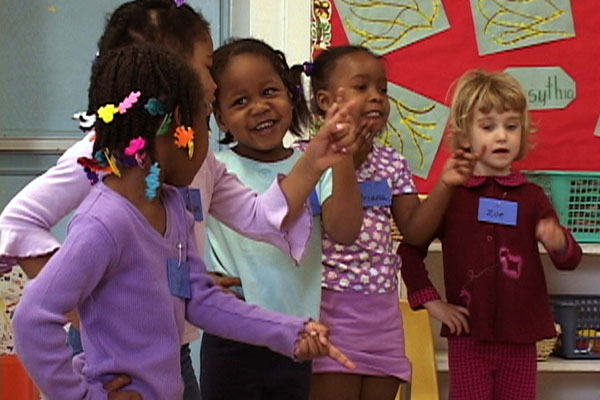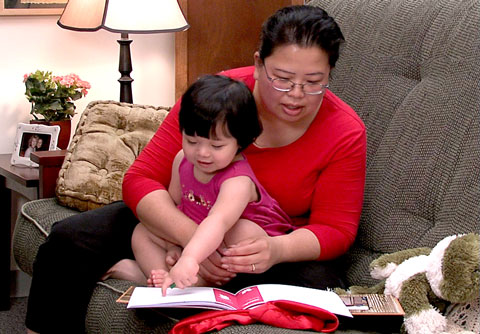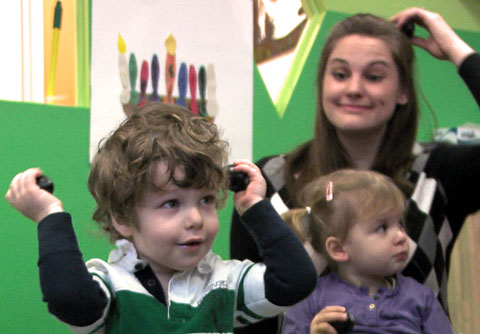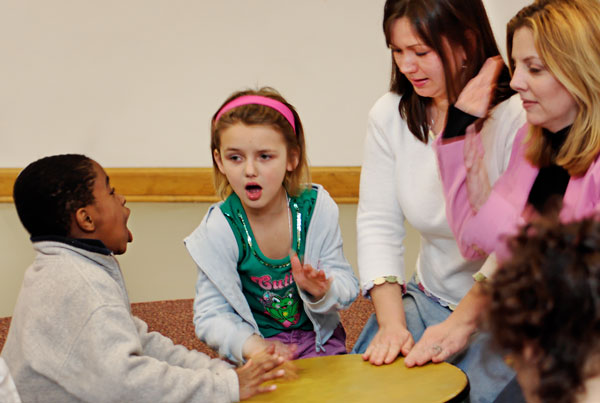Supporting Executive Function through Music-Making
By Frances Durkin, M.Ed., MBA
At Music Together, we say “music learning supports all learning®.” While our primary goal is to support children's music development, we know that music activities also foster children's growth in other domains essential to school and life success. Might music play a role in helping children who are homeless get ready for kindergarten by improving their executive function skills? Three years ago, a research team at the University of Minnesota, where I work as an early childhood specialist, launched a study to find out.

Executive function describes a set of mental tasks that are a major part of what makes us human. It gives us the ability to plan, resist impulses, keep multiple items in mind (working memory), and adapt to our surroundings. The acquisition of these skills depends upon the healthy development of the pre-frontal cortex of the brain, which grows rapidly during the early childhood years.
Kindergarten teachers hope that executive function is already present in their incoming students, but children living in stressful situations often experience a delay in developing these critical skills. The goal of the research study was to see if early intervention could help improve executive function in children living at People Serving People, a homeless shelter in Minneapolis.
Specialized work with children can increase the strength of executive function skills. Card games like Blink and children’s games like Simon Says support executive function, as players must remember rules and resist impulses to do or say one thing in favor of another. I suspected that some of the activities we do in Music Together support the development of executive function, so I proposed that the curriculum be included as part of the intervention.
Structure of intervention
A team of researchers well versed in the development of executive function joined forces with those familiar with the issues of homelessness to design an intervention for children ages three–five living at the shelter. There were three parts to the program:

- The classroom teachers at the homeless shelter preschool were trained in activities believed to “boost” executive function skills. The classroom teachers and children participated in two Music Together classes each week. Classroom teachers were encouraged to continue the Music Together activities throughout the week. Families were also given CD players so they would be able to listen to the music and try some activities on their own.
- Children were given one-on-one sessions with research assistants to aid in developing executive function skills.
- Parents were taught to be “executive function undercover agents,” noticing and encouraging their children’s early use of executive function skills. They were also given specific books and games to play with their children. At the close of the three weekly parent trainings, I led a shortened Music Together class where children and parents moved, sang, and played with instruments in ways consistent with executive function principles.
Using/Adapting Music Together Songs
I trained a group of local Music Together teachers in executive function concepts. Together, we analyzed the Music Together songs to choose those that were most rich in executive function elements. In collaboration with the research staff at Music Together’s headquarters, we brainstormed variations and music activities that would best support executive function.

As I’d thought, many Music Together activities already contain elements that support executive function, and others can be easily adapted. When we tap our knees and then clap and then add a third and fourth movement to the sequence, we’re supporting the same brain muscle that allows a child to remember a rule (“don’t grab!”) and then act on it. Asking children to copy movements with egg shakers is a common Music Together activity that promotes rhythm awareness. Asking them to do the reverse movement with the egg shakers (“opposite game”) supports executive function by challenging the children’s ability to keep a rule in mind and act on it—even when their impulse is to copy the example of the person in front of them.
In the classic Music Together call-and-response song “John the Rabbit,” the response is “yes, ma’am” until the very end, when it changes to “no, ma’am” in the last phrase. Asking children to make this change supports executive function, as it requires them to ignore their impulse to keep repeating the same phrase. When we did the song in class, we added some extra executive function “oomph.” We told the children we were going to try to trick them: They would have to watch my hand to know whether to respond with “yes, ma’am” (thumbs-up) or “no, ma’am” (thumbs-down).
Response/Results
Over the course of three years, 75 families were involved in the intervention. We plan to seek further funding so we can continue to develop and test the impact of the program. Early results are promising—and also indicate that there is more work to be done.
Selective attention, a key foundation of executive function, improved in the groups of children who received the intervention. Parents and teachers were very positive about the program—and the Music Together component was particularly singled out as appealing. However, there were striking individual differences in whether and how children changed as a result of their participation, indicating that we need to learn more about how to tailor the intervention to individual children, families, and classrooms.

Informally, there were many wonderful moments that demonstrated that the program was engaging and supporting the families and children. Once, I arrived early to set up the instruments for the second week of Music Together class. A few children came over to help me—and spontaneously started singing “Hey Ya Na” as we pulled out the drums! After we had finished one of the sessions, I ran into one of the moms who had participated. She told me that her daughter asks for the lullaby from class every night before bed. It was gratifying to hear that the music had touched this family’s daily routine in a positive way while they were living at the shelter.
Frances Durkin is a licensed Music Together teacher (Certification Level I) and is the Creativity Coordinator at the Shirley G. Moore Laboratory School at the University of Minnesota Institute of Child Development.



